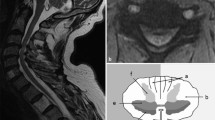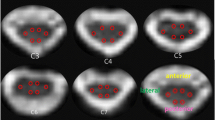Abstract
A retrospective study was performed to determine the sensitivities of the pyramidal signs in patients with cervical myelopathy, focusing on those with increased signal intensity (ISI) in T2-weighted magnetic resonance imaging (MRI). The relationship between prevalence of the pyramidal signs and the severity of myelopathy was investigated. We reviewed the records of 275 patients with cervical myelopathy who underwent surgery. Of these, 143 patients were excluded from this study due to comorbidities that might complicate neurological findings. The MR images of the remaining 132 patients were evaluated in a blinded fashion. The neurological findings of 120 patients with ISI (90 men and 30 women; mean age 61 years) were reviewed for hyperreflexia (patellar tendon reflex), ankle clonus, Hoffmann reflex, and Babinski sign. To assess the severity of myelopathy, the motor function scores of the upper and lower extremities for cervical myelopathy set by the Japanese Orthopaedic Association (m-JOA score) were used. The most prevalent signs were hyperreflexia (94%), Hoffmann reflex (81%), Babinski sign (53%), and ankle clonus (35%). Babinski sign (P < 0.001), ankle clonus, and Hoffmann reflex showed significant association with the lower m-JOA score. Conversely, no association was found with the upper m-JOA score. In patients with cervical myelopathy, hyperreflexia showed the highest sensitivity followed by Hoffmann reflex, Babinski sign, and ankle clonus. The prevalence of the pyramidal signs correlated with increasing severity of myelopathy. Considering their low sensitivity in patients with mild disability, the pyramidal signs may have limited utility in early diagnosis of cervical myelopathy.

Similar content being viewed by others
References
Bednarik J, Kadanka Z, Vohanka S, Novotny O, Surelova D, Filipovicova D, Prokes B (1998) The value of somatosensory and motor evoked potentials in pre-clinical spondylotic cervical cord compression. Eur Spine J 7:493–500
Chiles BW III, Leonard MA, Choudhri HF, Cooper PR (1999) Cervical spondylotic myelopathy: patterns of neurological deficit and recovery after anterior cervical decompression. Neurosurgery 44:762–769 (discussion 769–770)
Dillin WH, Watkins RG (1992) Clinical syndromes in cervical myelopathy. In: Rothman RH, Simeone FA (eds) The spine, 3rd edn. W.B. Saunders, Philadelphia, pp 560–570
Dvorak J, Sutter M, Herdmann J (2003) Cervical myelopathy: clinical and neurophysiological evaluation. Eur Spine J 12(suppl 2):S181–187
Emery SE (2001) Cervical spondylotic myelopathy: diagnosis and treatment. J Am Acad Orthop Surg 9:376–388
Glaser JA, Cure JK, Bailey KL, Morrow DL (2001) Cervical spinal cord compression and the Hoffmann sign. Iowa Orthop J 21:49–52
Herdmann J, Linzbach M, Kranz M, Dvorak J, Bock WJ (1994) The European Myelopathy Score. In: Bauer BL, Brock M, Klinger M (eds) Advances in neurosurgery. Springer, Berlin, pp 266–268
Hirabayashi K, Miyakawa J, Satomi K, Maruyama T, Wakano K (1981) Operative results and postoperative progression of ossification among patients with ossification of cervical posterior longitudinal ligament. Spine (Phila Pa 1976) 6:354–364
Holly LT, Dong Y, Albistegui-DuBois R, Marehbian J, Dobkin B (2007) Cortical reorganization in patients with cervical spondylotic myelopathy. J Neurosurg Spine 6:544–551
Holly LT, Moftakhar P, Khoo LT, Shamie AN, Wang JC (2008) Surgical outcomes of elderly patients with cervical spondylotic myelopathy. Surg Neurol 69:233–240
Houten JK, Noce LA (2008) Clinical correlations of cervical myelopathy and the Hoffmann sign. J Neurosurg Spine 9:237–242
Iwasaki M, Okuda S, Miyauchi A, Sakaura H, Mukai Y, Yonenobu K, Yoshikawa H (2007) Surgical strategy for cervical myelopathy due to ossification of the posterior longitudinal ligament: part 1: clinical results and limitations of laminoplasty. Spine (Phila Pa 1976) 32:647–653
Kamata M, Satomi K (1997) Classification of cervical myelopathy (in Japanese). MB Orthop 10:1–6
Lunsford LD, Bissonette DJ, Zorub DS (1980) Anterior surgery for cervical disc disease. Part 2: treatment of cervical spondylotic myelopathy in 32 cases. J Neurosurg 53:12–19
Mikulis DJ, Jurkiewicz MT, McIlroy WE, Staines WR, Rickards L, Kalsi-Ryan S, Crawley AP, Fehlings MG, Verrier MC (2002) Adaptation in the motor cortex following cervical spinal cord injury. Neurology 58:794–801
Morio Y, Teshima R, Nagashima H, Nawata K, Yamasaki D, Nanjo Y (2001) Correlation between operative outcomes of cervical compression myelopathy and MRI of the spinal cord. Spine (Phila Pa 1976) 26:1238–1245
Rhee JM, Heflin JA, Hamasaki T, Freedman B (2009) Prevalence of physical signs in cervical myelopathy: a prospective, controlled study. Spine (Phila Pa 1976) 34:890–895
Sakaura H, Hosono N, Mukai Y, Oshima K, Iwasaki M, Yoshikawa H (2008) Preservation of the nuchal ligament plays an important role in preventing unfavorable radiologic changes after laminoplasty. J Spinal Disord Tech 21:338–343
Seichi A, Takeshita K, Kawaguchi H, Nakajima S, Akune T, Nakamura K (2004) Postoperative expansion of intramedullary high-intensity areas on t2-weighted magnetic resonance imaging after cervical laminoplasty. Spine (Phila Pa 1976) 29:1478–1482 (discussion 1482)
Suri A, Chabbra RP, Mehta VS, Gaikwad S, Pandey RM (2003) Effect of intramedullary signal changes on the surgical outcome of patients with cervical spondylotic myelopathy. Spine J 3:33–45
Tsuji T, Asazuma T, Masuoka K, Yasuoka H, Motosuneya T, Sakai T, Nemoto K (2007) Retrospective cohort study between selective and standard c3–7 laminoplasty. Minimum 2-year follow-up study. Eur Spine J 16:2072–2077
Van Gijn J, Bonke B (1977) Interpretation of plantar reflexes: biasing effect of other signs and symptoms. J Neurol Neurosurg Psychiatry 40:787–789
Yonenobu K, Abumi K, Nagata K, Taketomi E, Ueyama K (2001) Interobserver and intraobserver reliability of the Japanese Orthopaedic Association scoring system for evaluation of cervical compression myelopathy. Spine (Phila Pa 1976) 26:1890–1894 (discussion 1895)
Yukawa Y, Kato F, Ito K, Horie Y, Hida T, Machino M, Ito ZY, Matsuyama Y (2008) Postoperative changes in spinal cord signal intensity in patients with cervical compression myelopathy: comparison between preoperative and postoperative magnetic resonance images. J Neurosurg Spine 8:524–528
Author information
Authors and Affiliations
Corresponding author
Rights and permissions
About this article
Cite this article
Chikuda, H., Seichi, A., Takeshita, K. et al. Correlation between pyramidal signs and the severity of cervical myelopathy. Eur Spine J 19, 1684–1689 (2010). https://doi.org/10.1007/s00586-010-1364-3
Received:
Revised:
Accepted:
Published:
Issue Date:
DOI: https://doi.org/10.1007/s00586-010-1364-3




